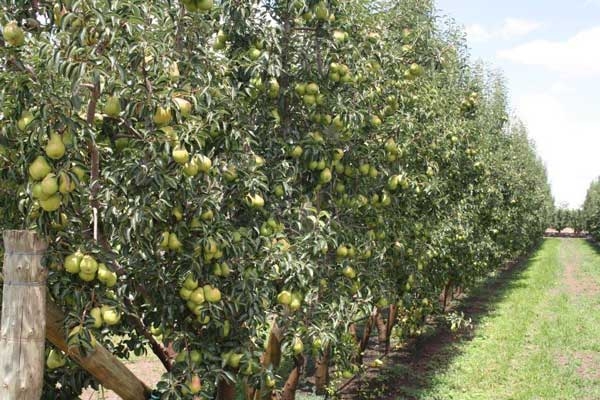High density planting (continued)
Pyrus calleryana D6 has been widely adopted in Australia since the 1950s.
It is hardy for arid Australia, compatible with all European pear varieties, easily propagated (from seed), and the scion can be made precocious if well managed.
It was not until Williams trees on Pyrus calleryana D6 rootstock were planted closely and trellised, nashi pollinisers were interplanted, beehives were introduced, RDI, drip irrigation and Ethrel were used to control shoot growth, that precocity improved and trees could be brought into full production by year six (see Tree Fruit November 2003, September 2004, May and June/July 2007).
How we achieved the highest ever production efficiency
In this article, we discuss our experiment where we significantly improved fruitfulness of Williams trees on Tatura Trellis which had performed poorly for 11 years and changed the traits of Williams to show the true production potential of this popular variety.
We increased fruit set of Williams trees by improving cross-pollination, using a synthetic stimulant, and control vigour.
We show how we calculated yield from bins of pears harvested and delivered to the cannery.
Experiment at Ardmona, Victoria
We focussed on tree management—not on waiting and hoping for the right size-controlling rootstock to turn up.
In 2003, a 0.37 ha block of Williams on Pyrus calleryana D6 was planted on Tatura Trellis (4.50 x 1.00 m = 2222 trees per hectare) at an orchard near Ardmona, Australia.
Initially, Packham trees were interplanted (7 per cent of trees) as pollinisers and two beehives were introduced during flowering.
When eight years old, the trees had only produced a total of 37 tonnes per hectare, so we decided to re-graft the Packham trees to Nijisseiki.
It the eleventh year, when the Nijisseiki trees had sufficient flowers and beehives were introduced, the Williams trees were sprayed with 15 ppm ProGibb SG (active constituent 400 g/kg Gibberellic acid) at 70 percent full bloom; RDI was applied; and the tops were delay-headed six weeks after full bloom to maintain canopy height at 2.70 m, measured vertically, which is 60 per cent of the width of the row.
Yield increased four-fold (19 to 81 t/ha), vigour slowed down and floral buds developed mainly on spurs, not laterals as before.
However, as a result of the long non-productive years, tree vigour of the Williams trees was still a concern.
Since Regalis® was not recommended for pear, we experimented in the twelfth year with foliar sprays of Payback™ (active constituent 250 grams per litre Paclobutrazol — Important note: Payback™ is not registered for use on pears in Australia).
The first spray of 2 litres of Payback per hectare was applied 10 days after petal fall when new shoots were about 25 mm long. The second and third sprays of 1 litre per hectare were applied at 10–day intervals after the first spray.
The effects of foliar sprays of Payback, two beehives, RDI and delay-heading:
- Suppressed growth of new shoots and bourse shoots.
- Flowers set fruit in clusters of threes and fours as a result of less competition for nutrients and carbohydrate reserves between flowers in a truss.
- Restricted early shoot growth which allowed more nutrient and carbohydrate reserves to go to early fruit growth.
- Maintained good distribution of sunlight throughout the canopies during summer.
- Resulted in a gross yield of 128 tonnes per hectare and a canning-grade (larger than 65 mm) yield of 123 tonnes per hectare (123 bins per acre).
- The lateral-bearing trait was changed from lateral-bearing to a predominantly spur-bearing, setting the trees up for high sustainable yields and ease of management.
In this simple field experiment, we have shown, that:
- Williams trees on Tatura Trellis can produce exceptionally high yields of fruit of good size and quality, enabling orchardists to become competitively profitable with this pear which is used not only for the fresh fruit market but also for processing
- We did this with tree management—without the use of a size-controlling rootstock.






















